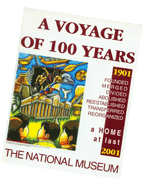ZOOLOGY DIVISION

Function
Conduct basic taxonomic research in zoology and its sub disciplines and disseminate scientific information; maintain reference collection.
Historical Notes
Undoubtedly one of the oldest pillars of the National Museum, the Zoology Division was born in 1901 with the passage of Act No. 284 establishing the Insular Museum of Ethnology, Natural History and Commerce. American zoologist Richard Crittenden McGregor was appointed as collector of natural history specimens and the first Division Chief of General Zoology and Ornithology. He soon began survey work and collecting expeditions together with a Filipino assistant, Mr. A. Celestino. The first trip was made in December of 1901 to the islands of Mindoro, Cagayan de Sulu, Palawan, Cuyo, and Culion.
Shortly thereafter, two successive administrative movements took place in 1904. McGregor and Celestino were asked tojoin the employees of the Bureau of Non-Christian Tribes, only to be transferred again to the Bureau of Government Laboratories, known later as the Bureau of Science. The transfer was appropriate since the laboratory building used to house the scientific library of the government aside from being the center of biological work of almost all government bureaus.
Notwithstanding the series of shaky events at the Bureau of Science, early American and Filipino zoologists concentrated on studying the fauna of the Philippines with emphasis on ecology, biology, and even exploitation. Thus, the names of Richard C. McGregor, Charles S. Banks, Alvin Seale,
Lawrence Griffin, Canuto G. Manuel, Dioscoro S. Rabor, Guillermo Blanco, Agustin F. Umali, Dominador Villaluz, Felix Arnola, Guillermo Ablan, Godofredo Alcasid, and Andres Mane became familiar figures in the Philippine Journal of Science, the first known and well-respected Philippine scientificjournal in the world.
The destructive war during the Japanese occupation of Manila in 1942 left nothing of the Bureau of Science Library including irreplaceable specimens and ichthyological and ornithological reference materials. Little was known of the developments after the war, although it is believed that scientists struggled to rebuild the collection through more extensive expeditions and studies.
Turning Points
The phenomenal turning point in the long history of the Zoology Division came in the early 1960s when the United States Army Research and Development Group sponsored the Museum - Migratory Animal Pathological Survey (MAPS), a bird-banding project that was carned out from 1962 to 1967. At the culmination of the project, the 1967 Annual Migratory Animal Pathological Survey Conference was held in the Philippines. This marked a first for the country.
This eventually led to the formal recognition of the National Museum as a scientific institution, as Museum Researchers were invited to participate in the first National Marine Animals Taxonomy Workshop and the National Committee on Marine Science the following year. This positive development continues to this day.
In the late 60s, the important exhibits "To Catch a Fish" and "Migrants Without Passports" were followed by a well received exhibit on "Rare and Vanishing Fauna in the Philippines" in the early 70s. Year after year, zoological exhibits have become more interesting and captivating, such as: the true-to-life showcase of Philippine insects and butterflies and the huge fish displays in Bolinao, Pangasinan in 1998; the Philippine Fauna Exhibits at the Old Congress Building in 1998; the Palawan Zoological Exhibit consisting of attractive dioramas on marine and terrestrial Palawan fauna in 2000; and the newly-installed Exhibit and Walk-in Diorama on Philippine Terrestrial Fauna and the Butterfly Garden in Fort Pilar, Zamboanga City.
Finally, the continuing surveys and collection efforts in various zoological disciplines yielded the discovery of new records and new species from 1961 to 2001. Undoubtedly, the number is still increasing as Museum Researchers tirelessly pursue their survey and collection activities in many different parts of the Philippines.
A Broader Role
From a hundred years back, the Zoology Division has remained steadfast in its commitment to respond to the mandate of the National Museum. Then and now, its concern, aside from exhibitions and education, is the inventory, study, and preservation of the rich Philippine fauna covering birds, mammals, crustaceans, shells and mollusks, insects, reptiles, corals, fishes, echinoderms, polychaetes and sponges, from both land and marine areas. These mandates were recently strengthened by the National Museum Act of 1998.
As a result, however, of the changing milieu in the socio-economic and political arena, the Division has broadened its role into that of being an active participant in policy development. In 1999, for instance, it provided valuable inputs in the creation of the "Philippine Wildlife Act" that seeks to protect our wildlife including its trade, research, and sustainable use.
Quest for Excellence
The National Museum's scientific experts and researchers in the field of zoology are richly endowed with a natural flair for research and development. Many of them have their names permanently inked in the pages of the Philippine Journal of Science because of the number and variety of studies undertaken which are indeed a source of pride and prestige for the agency.
As a result of these researches, the Zoology Division has produced a substantial number of identified new species or new records of different Philippine fauna in the last 40 years. In 1996, for instance, 12 new species of sponges were discovered from the old materials in the national reference collections of the Museum which were left unreported until then. This unexpected imd has led to the updating of synonymy of some sponge species. In the same vein, 15 new records and one new species of crustaceans were discovered from the collections of the National Museum in 1999. Still another noteworthy discovery, because of its economic potential, is that of a large eunicid worm, Marphysa sp., along the mangrove swamps of Buenavista, Guimaras in 1998.
As international institutions recognized the capability and expertise of their local counterparts, more scientific endeavors have been extended. A case in point is the Biodiversity Information Center - Animal Unit (BIC-AU), a special project under a US$67,000 grant from Mac Arthur Foundation. Being conducted in conjunction with the Botany Division, the BIC-AU project involves the collection of voucher specimens, scientific identification, assessment of threats and economic potential of Philippine animals. It also manages a special library on biodiversity surveys, conservation and other issues. Two very interesting components of this project are the databasing and presentation of complete , zoological collections, and the launching of a CD-ROM Birdbase Introductory version.
Also part of the Division's global interaction is the continued conduct of and participation in seminars/workshops and conferences, such as the First Herpetological Symposium held at the National Museum and the First Symposium on the Biogeography and Systematics of Philippine Amphibians and Reptiles which were both attended by leading herpetologists from all over the world.
As if present efforts are still not enough, scientific globalization through the exchange of publications with foreign experts and institutions is being pursued. In 1998, an update on crustacean research was made possible by the donation of scientificjournals from the University of Singapore, University of Hawaii, National Science Museum of Japan and the Smithsonian Institution.
Remarkably, so much was accomplished in the last century but certainly so much still has to be done. The Zoology Division with Curator Rodolfo A. Caberoy (Poriferologist) and Assistant Curator Jaime J. Cabrera (Conchologist) as well as its 18 researchers and staff are all geared to move forward with utmost dedication toward the new challenges of the next century of the Museum.
taken from the
"A Voyage of 100 Years"



